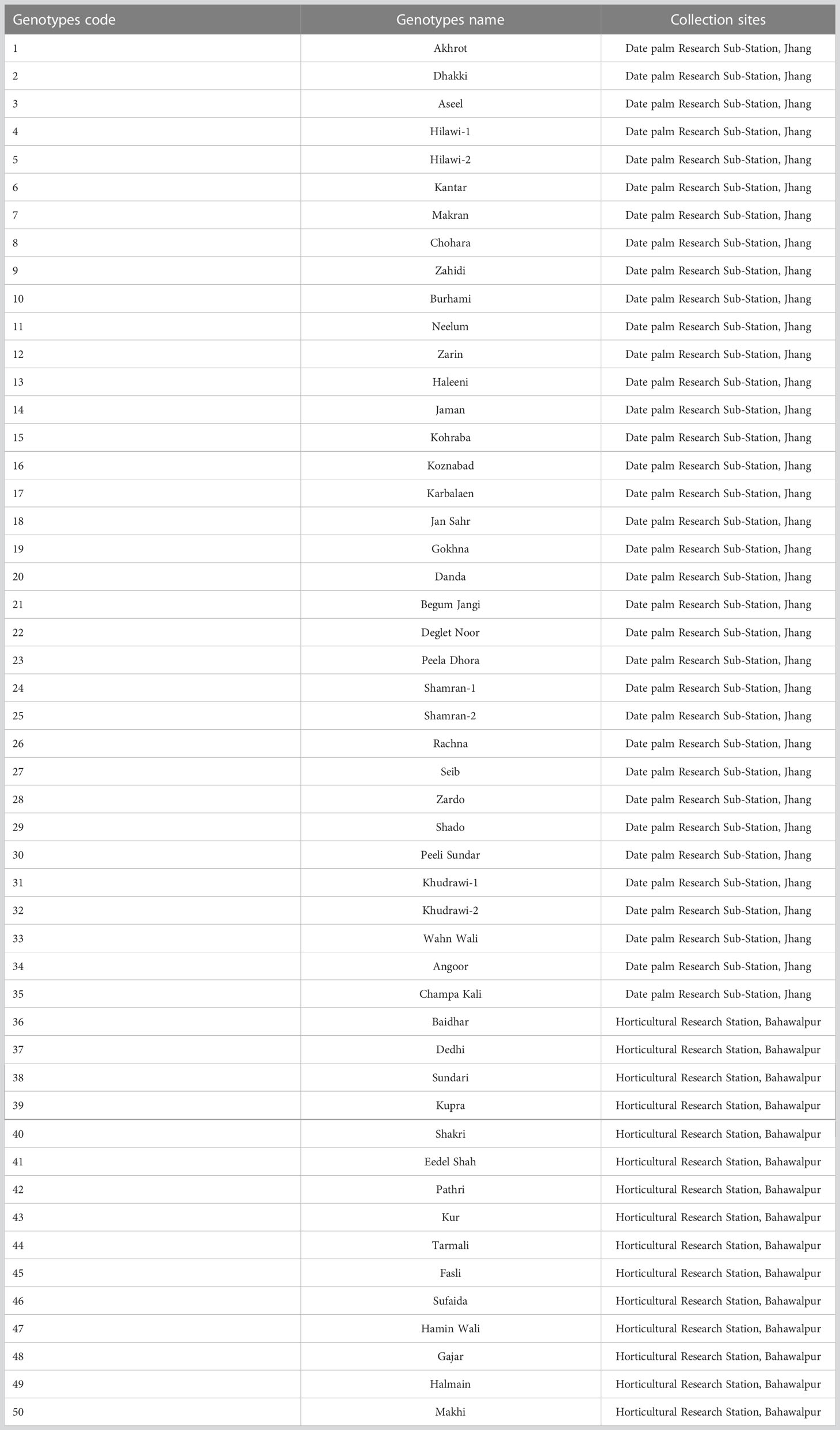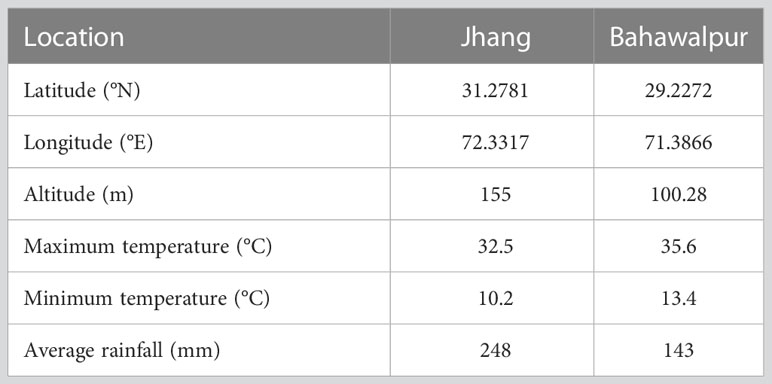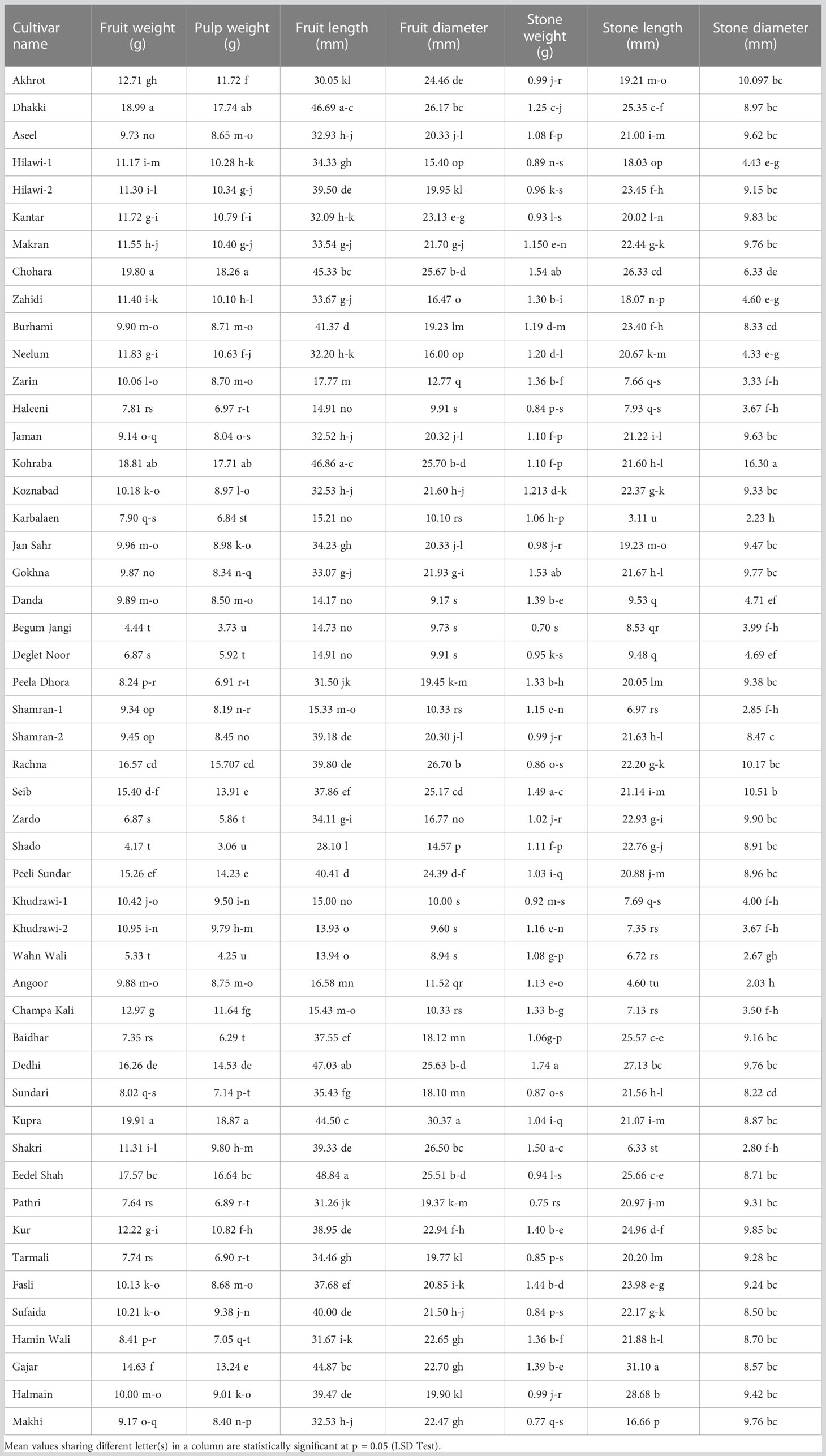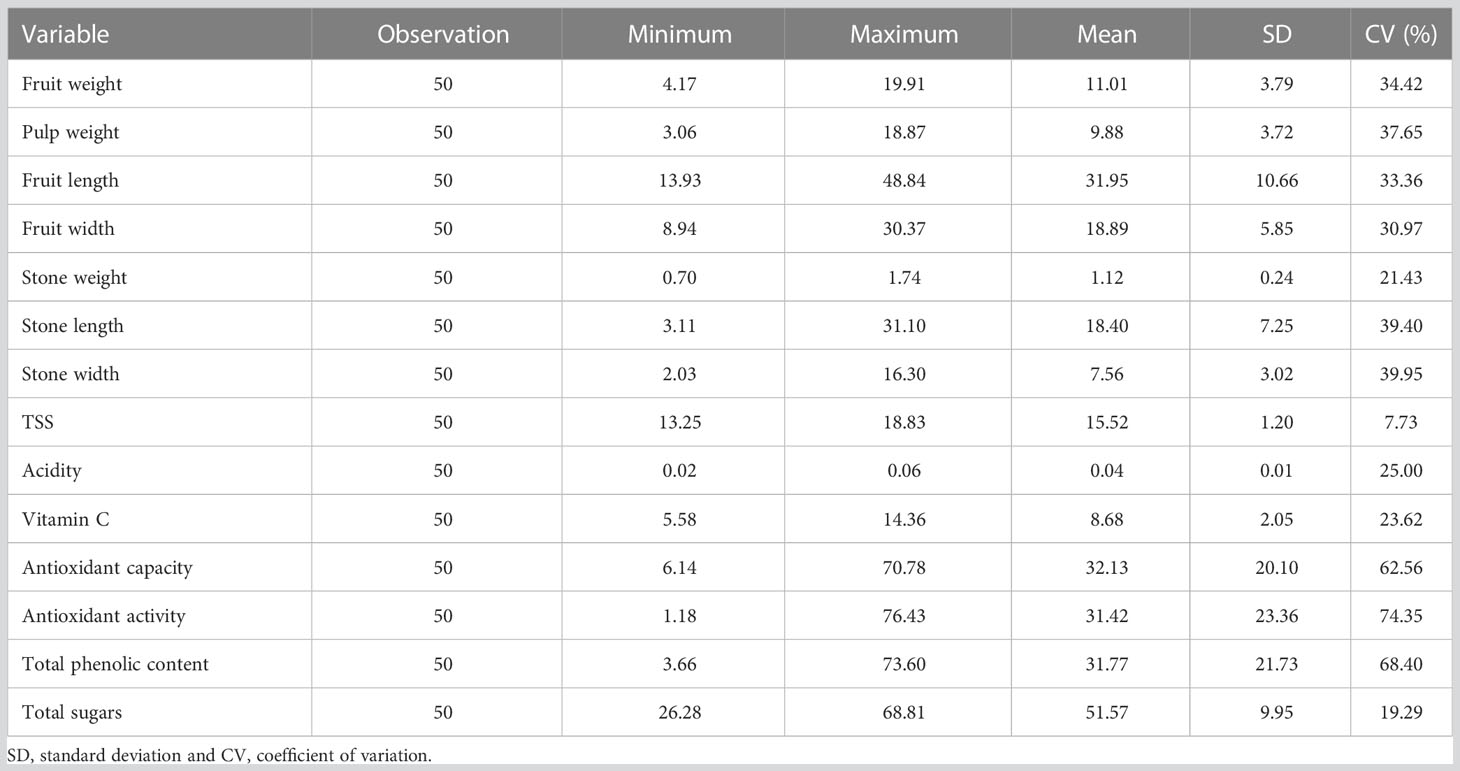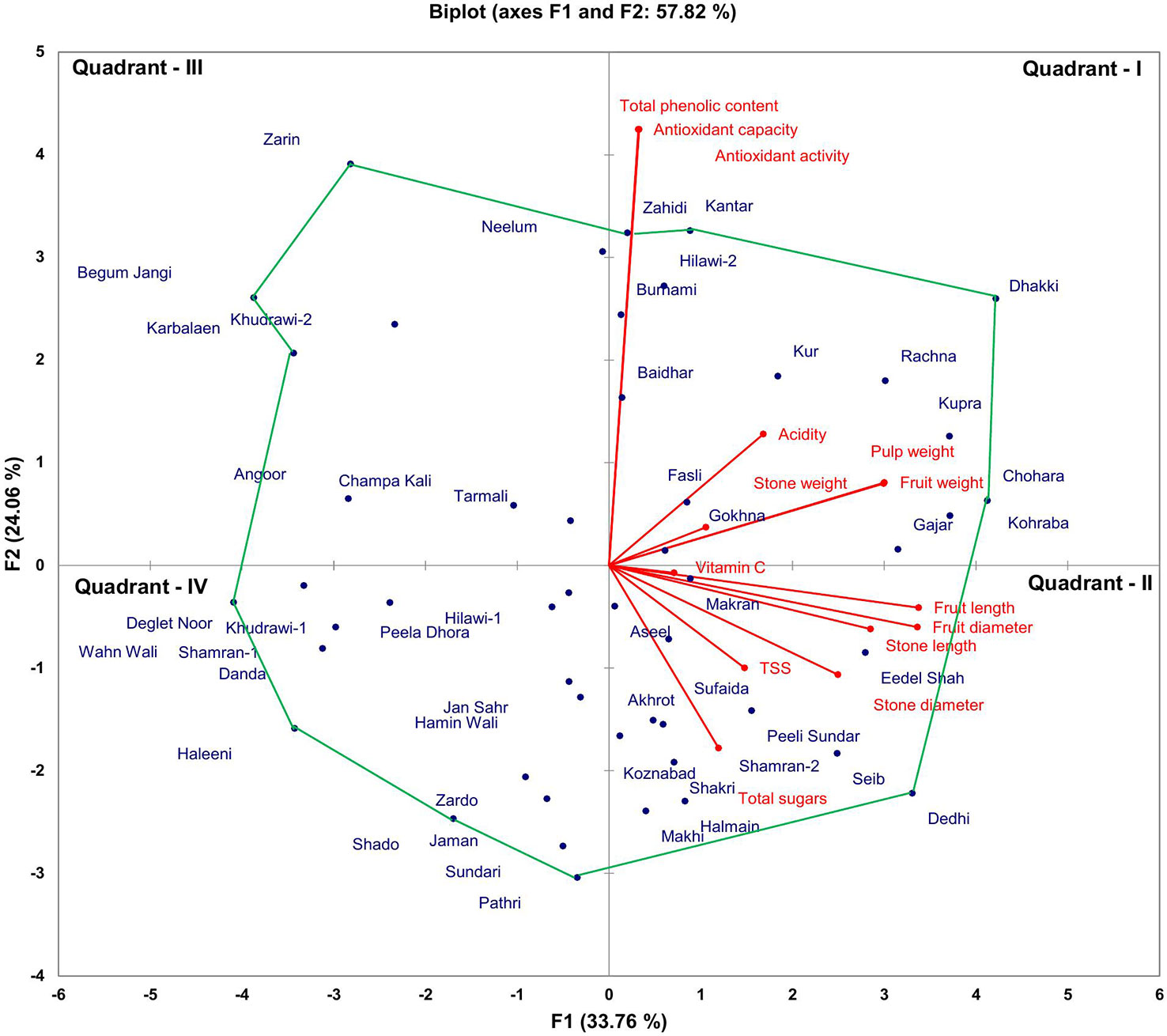- 1Department of Horticulture, The University of Agriculture, Dera Ismail Khan, Pakistan
- 2Department of Botany and Microbiology, College of Science, King Saud University, Riyadh, Saudi Arabia
- 3The National Institute of Horticultural Research, Konstytucji 3 Maja 1/3, Skierniewice, Poland
- 4Plant Production Department (Horticulture-Pomology), Faculty of Agriculture, Saba Basha, Alexandria University, Alexandria, Egypt
- 5Department of Horticulture, Faculty of Agriculture, Ataturk University, Erzurum, Türkiye
- 6Department of Horticulture, Bahauddin Zakariya University, Multan, Pakistan
Date palm is an economically important fruit crop in the arid and semi-arid regions of the world. The knowledge of genetic variation, genotype-by-traits comparison, as well as the relationship among several phenological traits is effective for developing breeding populations by choosing the best allelic combinations and employing selection approaches. Information regarding the genetic variability and inter-relationships among fruit characteristics is facilitating the plant breeders to efficiently exploit the date palm germplasm for the introduction of elite genotypes. The present study was conducted to examine genetic variation among different date palm cultivars -collected from two different research stations in Pakistan as well as the relationship among their phenological and biochemical characteristics. Biplot analysis revealed that the cultivars ‘Dhakki’, ‘Chohara’, and ‘Kupra’ possessed the highest fruit and pulp weights. Moreover, the fruits of the cultivars ‘Champa Kali’ and ‘Shakri’ had the maximum TSS (total soluble solids) and total sugar content. Similar variations were observed in the mean values of the studied phenological and biochemical characteristics as in the biplot analysis. Cluster analysis on the basis of phenological and biochemical characteristics divided 50 cultivars into seven clusters, showing differences in the studied characters. A correlation matrix revealed that pulp weight had a strong relationship with fruit weight, length, and diameter. A strong correlation also existed among antioxidant capacity, antioxidant activity, and total phenolic content. These results demonstrated a huge diversity in phenological and biochemical characteristics of date palm cultivars as well as a correlation among several characteristics of the studied germplasm, which can be exploited in future breeding programs.
Introduction
Date palm (Phoenix dactylifera L.) belongs to the family Arecaceae (Arabnezhad et al., 2012) with probable centers of origin Middle East, Western Asia, India, and Iraq (Ataga et al., 2012). It is a perennial and dioecious fruit tree (Khan et al., 2012). It is an important fruit crop due to its commercial production and cultivation in arid and semi-arid areas of Africa, the Middle East, and South Asia (Kumar et al., 2010). It is extensively cultivated as a major fruit crop in desert areas in Pakistan (Ata et al., 2012). Its fruit has been used as food for more than 6000 years (Shahib and Marshall, 2003). It is an excellent source of carbohydrates, proteins, vitamins, antioxidants, dietary fibers, carotenoids, anthocyanin, and minerals (Tang et al., 2013; Hatami et al., 2023). Thus, it provides high nutritional value for people and is considered a basic part of the human diet in several countries (Mortazavi et al., 2015). These nutritious compounds may vary among the cultivars and depend on the fruit developmental stage as well as the agronomic practices adopted. Its fruit has great potential against chronic diseases, i.e., cardiovascular disease, cancer, diabetes, atherosclerosis,s and neurodegenerative disease (Muralidhara et al., 2017).
Palm date is mostly cultivated through offshoots to ensure the uniformity of cultivars but cross-pollination is one cause of genetic variation in seeded populations and hybrids (Hammadi et al., 2009; Naqvi et al., 2015). Genetic variability among date palm genetic resources has been the basis for the development of high-yielding genotypes. Genetic variation in genotypes enhances the heterozygosity that will further improve crop resistance against biotic and abiotic stresses (Ahmad and Anjum, 2018). These variations also provide allelic variability that might be utilized for the development of new cultivars (Ahmad et al., 2020). The introduction of exotic germplasm, mutation, polyploidy, and hybridization are imperative breeding tools that can be helpful to evaluate superior progenies (Haider et al., 2015). The most important indigenous date palm cultivars are Aseel, Dhakki, and Begum Jungi, and many other local and exotic cultivars are grown in arid and semi-arid areas in Pakistan (Iqbal et al., 2012). The proper description of cultivars through phenological and biochemical traits is imperative because it provides valuable information for further breeding purposes (Pommer, 2012). Usually, genetically diverse parents are selected by plant breeders for hybridization due to greater variability level which provides the path for maximum improvement of the target traits (Akhtar et al., 2014).
Phenological and biochemical characterization, i.e., collecting the necessary information on date palm cultivars, is a prerequisite before starting any breeding strategy for crop improvement programs. Phenological traits are more important for the determination of maturity indices and shelf life of fruits (Awan et al., 2018). These are also very helpful for the sorting, grading, and processing of fruit. Generally, the proper stage for fruit harvesting is the ‘rutab’ stage as compared to the ‘khalal’ stage, to avoid fruit ripening failure. When fruit is harvested at the ‘khalal’ stage, it takes more time to dry and is unable to develop superior fruit quality. Biochemical traits provide nutritional and health benefits that are vital for consumers. There is thus an urgent need to examine the phenological and biochemical traits of date palm germplasm (Ahmad et al., 2020). Accurate information regarding the phenological and biochemical traits of different cultivars is an important factor for better exploitation of the germplasm (Ahmad et al., 2020). The knowledge of genetic variations and their linkage within or among the populations is a prerequisite for better understanding the available genetic inconsistency for further usage in advanced breeding. The description carried out using a huge set of phenological and biochemical traits provides the basis for the evaluation of genetic diversity among date palm genotypes using a multivariate approach (Mehmood et al., 2013).
For germplasm characterization and evaluation, it is necessary that variations among evaluated materials be identified precisely and reliably. In the current scenario, there is an urgent need to identify the phenological and biochemical diversity of fruits for their better utilization and provide essential data for consumers, processors, and exporters. From previous literature, it has been revealed that the phenological and biochemical characterization of the genotypes may also initiate association mapping studies in the future to distinguish the markers linked with economically important traits. Hence, the current study was conducted to highlight the appropriate identification strategies for varietal characterization and registration purposes, and the correction of misnamed date palm genotypes available in Pakistan.
Materials and methods
Plant materials
A set of fifty cultivars of date palm was selected from two different research stations in Punjab, Pakistan (Table 1). The trees of each cultivar were tagged for two years (2017 and 2018) to collect their fruit. The fruits of these cultivars were harvested at the ‘rutab’ stage to record data on different phenological and biochemical traits. The phenological and biochemical data of 20-year-old trees were arranged in a randomized complete block design (RCBD). Geographical and meteorological data from Bahawalpur and Jhang locations are presented in Table 2.
Phenological traits
Twelve fruits were randomly taken from each replication of each cultivar for an evaluation of phenological traits. For this purpose, the descriptors used were as described by Rizk and El Sharabasy (2018). Fruit weight (g), pulp weight (g), and stone weight (g) were measured using a digital weighing balance. Fruit length (mm), fruit diameter (mm), stone length (mm), and stone diameter (mm) were measured using a Vernier caliper.
Biochemical traits
For biochemical analysis, 40 g of fruit samples were ground in 60 ml of distilled water using a dilution factor. The total soluble solids (°Brix) in the fruit juice were estimated using a hand refractometer. Fruit acidity (%) was determined by using a method described previously (Anjum et al., 2018). Vitamin C content (mg 100 mL-1) was calculated from the juice, by the method described by Ruck (1963). Then, 30 µl of fruit juice extract and 2.97 ml of DPPH were mixed in test tubes. The homogenized mixture was kept in the dark for 30 min and an absorbance reading was noted for the estimation of antioxidant capacity. Antioxidant capacity (mM Trolox 100 ml-1) and antioxidant activity (%) of fruits were estimated as described earlier (Ozgen et al., 2010). Approximately 1 ml of date juice, 1 ml of Folin-Ciocalteu’s phenol reagent, and 10 ml of sodium carbonate were added to 20 ml of distilled water for estimation of total phenolic content (µg GAE ml-1) in fruits as described by Ainsworth and Gillespie (2007). Hortwitz (1980) method was followed for the determination of total sugar content (%).
Statistical analysis
The phenological and biochemical data were analyzed using the statistical software, Statistix 8.1 (Tallahassee Florida, USA), with three replications for each cultivar. The treatment means were separated using a least significant difference (LSD) test at a 5% probability level. Correlation matrixes were constructed using R statistical software. Biplot analyses were made using XLSTAT, 2023 and dendrograms (Ward linkage, Pearson distance) were constructed using Minitab.
Results
Mean values of phenological and biochemical traits
The ‘Chohara’ cultivar showed the highest fruit weight (19.80 g) and pulp weight (18.26 g). ‘Eedel Shah’ had the largest fruit length (48.84 mm) and ‘Kupra’ exhibited the largest fruit diameter (30.37 mm). ‘Dedhi’ showed the highest stone weight (1.74 g). ‘Gajar’ had the largest stone length (31.10 mm) and the largest stone diameter was observed in ‘Kupra’ (30.37 mm) as shown in Table 3.
The mean values also confirmed the best-performing cultivars with 18.83°Brix of TSS and 14.36 mg/100 ml of vitamin C content for ‘Champa Kali’, and 18.75°Brix of TSS and 68.81% of total sugar content in ‘Shakri’ (Table 4). Moreover, the ‘Neelum’ cultivar demonstrated the highest antioxidant capacity, antioxidant activity, and total phenolic content with values of 70.78 mM Trolox/100 ml, 76.43%, and 73.60 µg GAE/ml, respectively.
Coefficients of variation of phenological and biochemical traits
Coefficients of variation for seven phenological and biochemical traits were calculated for fifty date palm cultivars (Table 5), which showed the levels of variation among all the studied traits. Stone length showed the highest variability (39.95%), while the lowest was observed in stone weight (21.43%). Coefficients of variation revealed higher variability in antioxidant activity (74.35%), while the lowest was recorded for TSS (7.73%).
Principal component analysis
The eigenvalue showed that the first four components (fruit weight, pulp weight, fruit length, and fruit diameter) showed the maximum variability among the studied traits of date palm cultivars. However, others showed negligible contribution to the variability of date palm cultivars (Table 6).

Table 6 Principal component analysis of phenological and biochemical traits of 50 date palm cultivars.
Biplot analyses of phenological and biochemical traits
Biplot was developed based on the first two components and both components shared a maximum variability of 57.82%. The biplot analysis for phenological biochemical traits revealed that the date palm cultivars, i.e., ‘Dhakki’, ‘Zahidi’, ‘Kantar’, ‘Zarin’, ‘Begum Jangi’, ‘Karbalaen’, ‘Wahn Wali’, ‘Haleeni’, ‘Sundri’, ‘Pathri’, ‘Dedhi’, ‘Kohraba’, and ‘Chohara’, were at the vertex of a polygon. Among these, some genotypes, i.e., ‘Dhakki’, ‘Zahidi’, ‘Kantar’, ‘Dedhi’, ‘Kohraba’, and ‘Chohara’, were found to be more diverse because these were found to be away from the center of the trait vectors. Moreover, genotypes grouped into quadrants I and II showed good performance for the phenological and biochemical traits as compared to quadrants III and IV (Figure 1).
Cluster analysis of genotypes based on phenological and biochemical traits
A dendrogram based on the phenological traits divided the date palm cultivars into seven major clusters (Figure 2A). Cluster 1 comprises a large set of cultivars, i.e., ‘Akhrot’, ‘Karbalaen’, ‘Aseel’, ‘Haleeni’, ‘Kantar’, ‘Kohraba’, ‘Zahidi’, ‘Baidhar’, ‘Deglet Noor’, ‘Hamin Wali’, ‘Jan Sahr’, and ‘Kur’. Two cultivars, ‘Haleeni’ and ‘Aseel’, shared the highest similarity with each other. A dendrogram based on the biochemical traits of the date palm cultivars also grouped the cultivars into seven clusters (Figure 2B). Cluster 2 contained a large set of cultivars, i.e., ‘Aseel’, ‘Deglet Noor’, ‘Gokhna’, ‘Peela Dhora’, ‘Wahn Wali’, ‘Hamin Wali’, ‘Hilawai-1’, ‘Sufaida’, ‘Eedel Shah’, ‘Makran’, ‘Khudrawi-1’, ‘Kohraba’, ‘Angoor’, ‘Tarmali’, ‘Karbalaen’, and ‘Fasli’. Two cultivars, ‘Haleeni’ and ‘Akhrot’, were very similar to each other among all the studied cultivars.
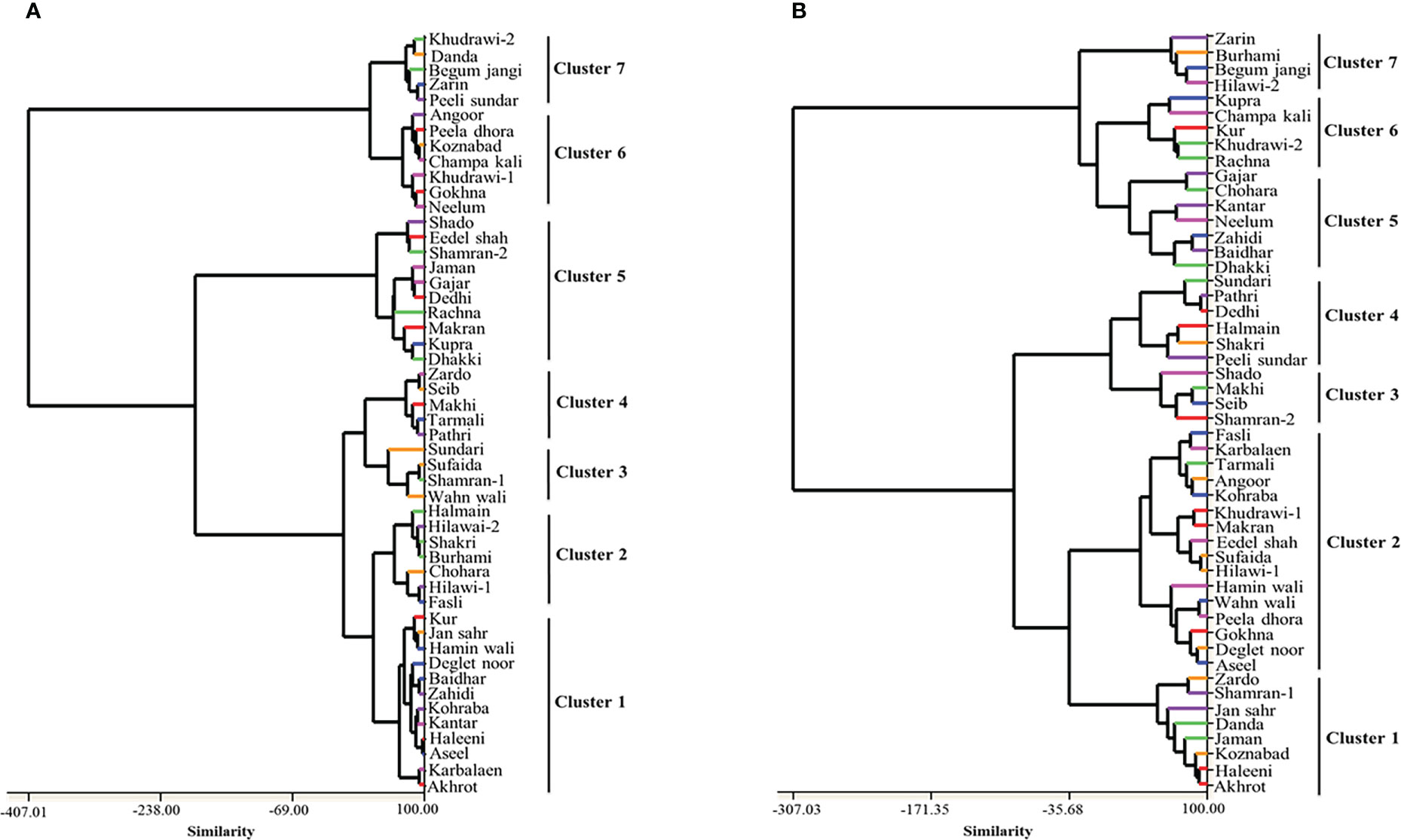
Figure 2 Dendrogram showing relationship among 50 date palm cultivars based on pomological (A) and phytochemical (B) characters.
Trait association analysis based on phenological and biochemical traits
The correlation matrix for phenological traits revealed that fruit weight had a significant association with pulp weight, and fruit length and diameter, while it had a non-significant association with stone weight, length, and diameter. However, stone weight did not show any association with pulp weight, and stone length and diameter (Figure 3A). Fruit length showed a significant association with fruit diameter, and stone length and diameter. This association was also confirmed by the biplot analysis as the angle between trait vectors of fruit weight and fruit pulp was less than 90°. Trait association was evaluated through a correlation matrix for biochemical traits (Figure 3B). Antioxidant capacity showed a significant association with antioxidant activity and total phenolic content. This association was also confirmed by the biplot analysis as the angle between trait vectors of antioxidant capacity, antioxidant activity, and total phenolic content was less than 90°. The biplot analysis also proved that the correlation matrix is an efficient multivariate tool for the evaluation of trait association among date palm cultivars.
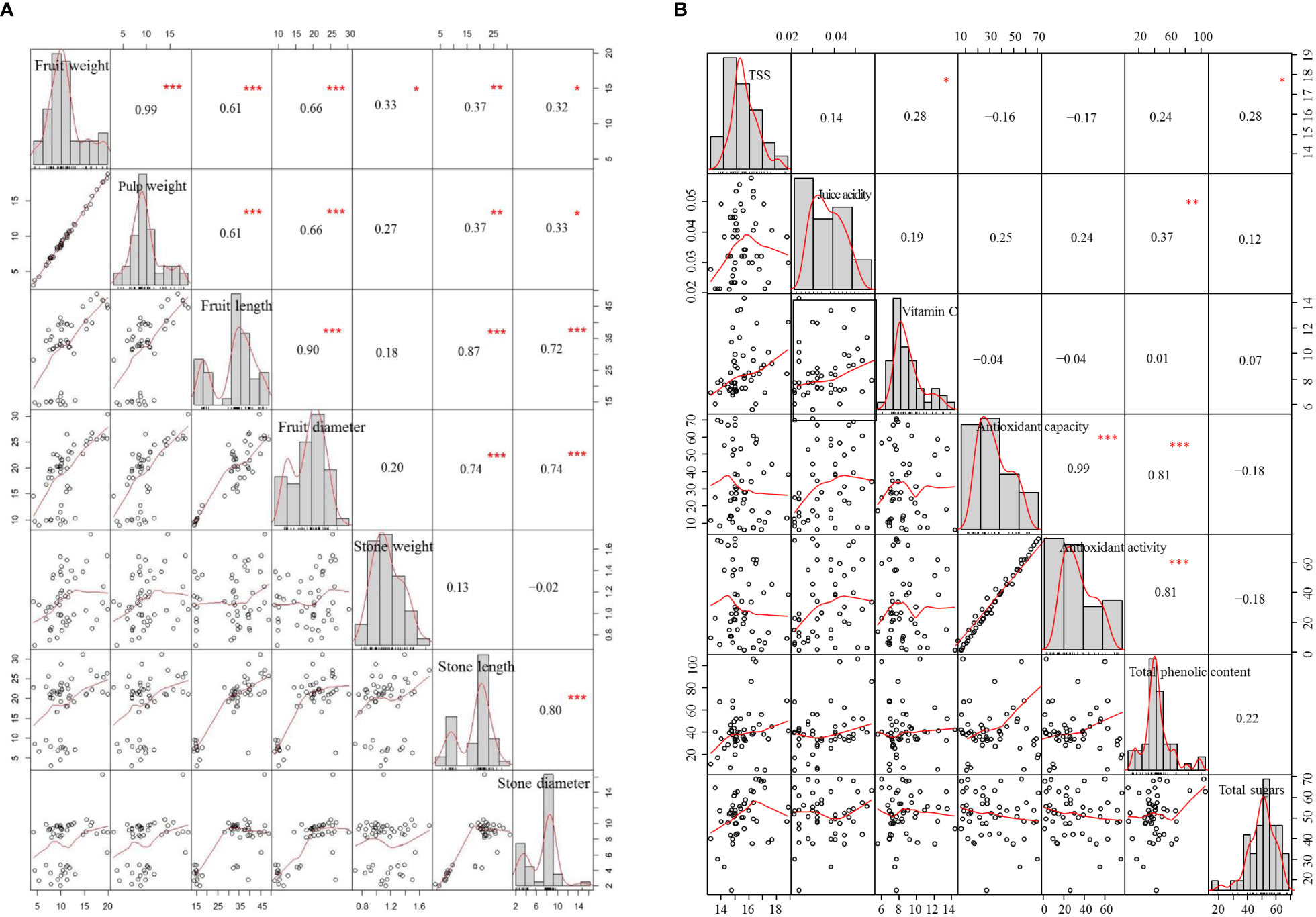
Figure 3 Genotype-by-trait association in pomological (A) and phytochemical (B) characters of 50 date palm cultivars.
Discussion
Date palm fruit is considered a good source of carbohydrates, protein, minerals, vitamins, and dietary fiber (Hatami et al., 2023). Genetic variations enhance heterozygosity, which can be exploited to improve crop tolerance against biotic and abiotic stresses. Genetic makeup, climatic conditions, cultural practices, plant nutrition, seed propagation, and cross-pollination are major causes of genetic variability in date palm genotypes. Low crop yield, poor fruit quality, misnaming, and a dioecious nature are major problems for the modern breeding of date palm genotypes (Ashraf et al., 2018). In the present study, readily available date palm germplasm was collected from two research stations in Pakistan. The presence of extensive variation in phenological and biochemical traits depicted ample scope for the characterization of date palm germplasm. Fruit characterization is the foundation for crop evolutionary studies, management of genetic resources, evaluation of the uniqueness of genotypes, and providing basic information for the development of excellent genotypes.
A multivariate approach has been found very effective for the identification of diverse germplasm with desired traits (Wu et al., 2019; Sarikhani et al., 2021). Mean performance and standard deviation can also be utilized for the evaluation of genotypic variation (Faqir et al., 2018). Biplot analysis can be used to identify important traits and genotypes that are the major contributory factors in the variability of date palm germplasm. It is an effective tool for the evaluation of cultivar performance and multidirectional association among different traits (Ennouri et al., 2018). The vertex cultivars in the biplot are those furthest from the biplot origin and these can be excellent or poor in few or all studied traits (Salem et al., 2008). The biplot analysis for phenological traits of the date palm cultivars showed that six cultivars, i.e., ‘Dhakki’, ‘Zahidi’, ‘Kantar’, ‘Dedhi’, ‘Kohraba’, and ‘Chohara’, were at the vertex and were good for phenological and biochemical traits. Biplot analysis depicted that these diverse cultivars for phenological and biochemical traits can be utilized as a source for improvement of elite date palm genotypes and selection breeding might be a suitable approach to bring further improvement in these genotypes or their traits. The mean values of the phenological and biochemical parameters depicted extensive variation in date palm cultivars and this was also confirmed by biplot analysis. This demonstrates that biplot analysis can be used as an alternative tool for the evaluation of genetic variation.
Cluster analysis could be effective for the identification of high yielding genotypes (Faqir et al., 2018). In this study, a dendrogram was constructed which grouped fifty cultivars into seven major clusters based on phenological traits. Two cultivars, ‘Haleeni’ and ‘Aseel’, showed a close genetic relationship as compared to all other studied cultivars and these were grouped together in Cluster 1. The association of studied cultivars for phenological traits during cluster analysis was similar to the biplot analysis. Moreover, cluster analysis also grouped these fifty cultivars into seven major clusters based on biochemical traits. A close relationship was shown between the ‘Sufaida’ and ‘Hilawai-1’ cultivars in Cluster 2 and the highest genetic association was found between the ‘Pathri’ and ‘Dedhi’ cultivars in Cluster 4. The distribution of the fifty date palm cultivars, irrespective of their center of origin, in seven clusters showed that the cluster analysis failed to detect any relationship between genetic divergence and geographical origin. Moreover, the geographical distribution of genotypes is not only the factor that is responsible for genetic diversity. It may possibly be due to genetic drift, artificial selection, climatic conditions, and the exchange of breeding materials. Thus, the selection of parent lines for future breeding purposes might be based on genetics instead of geographical diversity (Salem et al., 2008). Hybridization should be performed among the genotypes of different clusters rather than those of the same cluster to enhance heterosis and desired genetic recombinations (Sharif et al., 2019).
A correlation matrix provides a symmetrical association among a large number of traits (Faqir et al., 2018). A correlation matrix is helpful when an indirect assortment of secondary traits is utilized for the improvement of primary desired traits (Sharif et al., 2019). Fruit weight showed a significant positive correlation with pulp weight, fruit length, fruit diameter, stone weight, stone length, and stone diameter. Antioxidant capacity showed a significant positive correlation with antioxidant activity and total phenolic content. TSS showed a significant association with total sugar content. A similar trait association was revealed through the biplot analysis. These significant positive associations illustrated that all these traits gave similar evidence regarding the differences among genotypes and have a tendency to differentiate the genotypes in a similar manner (Amiri et al., 2010). Among the phenological traits, fruit, pulp, and stone weights were found to be more diverse traits in the studied germplasm as revealed by the mean values and the biplot analysis. Among the biochemical traits, TSS, pH, and vitamin C were found to be more divergent among all the studied germplasm as revealed by the mean values and the biplot analysis. However, cluster analysis is also effective for indicating similarity/dissimilarity among the collected date palm germplasm. A large similarity was recorded in the studied germplasm. Therefore, it is necessary to introduce higher-yielding germplasm for the broadening of the gene pool (Ahmad et al., 2023). It is advocated that great effort, time, and resources might be saved without sacrificing valuable data if an indirect selection is implemented for the improvement of desired traits (Harthi et al., 2015).
Conclusion
Date palm has diverse germplasm, hence the collection and preservation of this germplasm is a pre-requisite for future crop improvement programs. The characterization of this germplasm is important particularly when evaluated traits are directly related to fruit quality and crop yield. Thus, accurate information on phenological and biochemical traits provides a better guideline for diverse parent selection in breeding programs for the production of ideal products focused on producer and consumer demands. This study demonstrated that large variations exist in the phenological and biochemical traits of date palm cultivars that can be utilized for various crop improvement purposes. Conclusively, the results of the current study might be suitable to manage germplasm collection and helpful for choosing parents in future breeding programs for date palm genotypes.
Future recommendations
Fruit yield and quality traits are still gaining more attention in the breeding of fruit crops. It has been recommended that phenological and biochemical traits are major points of concern for the identification of higher-yielding elite genotypes. Moreover, mean values, coefficients of variation, biplot analysis, cluster analysis, and trait association are alternative tools for providing the appropriate information for the evaluation of genetic diversity which can be further utilized during diverse parent selection involving new commercial and high-yielding genotypes.
Data availability statement
The original contributions presented in the study are included in the article/supplementary material. Further inquiries can be directed to the corresponding author.
Author contributions
RA, HMA and MAA: Conceptualization, Literature review, Writing major and original draft. AL, WFAM and SE: Literature survey, Writing review and editing, Figure designing. All authors contributed to the article and approved the submitted version.
Funding
This work was funded by the Researchers Supporting Project number (RSP2023R123), King Saud University, Riyadh, Saudi Arabia.
Acknowledgments
Authors would like to extend their sincere appreciation to the Researchers Supporting Project number (RSP2023R123), King Saud University, Riyadh, Saudi Arabia.
The authors would like to extend also their sincere appreciation to the Horticulturists, Horticultural Research Station, Bahawalpur, and Date palm Research Sub-Station, Jhang, Pakistan for providing the fruit samples and to the Department of Horticulture, Bahauddin Zakariya University, Multan, Pakistan for providing research facilities to conduct the study.
Conflict of interest
The authors declare that the research was conducted in the absence of any commercial or financial relationships that could be construed as a potential conflict of interest.
Publisher’s note
All claims expressed in this article are solely those of the authors and do not necessarily represent those of their affiliated organizations, or those of the publisher, the editors and the reviewers. Any product that may be evaluated in this article, or claim that may be made by its manufacturer, is not guaranteed or endorsed by the publisher.
References
Ahmad, R., Anjum, M. A. (2018). Applications of molecular markers to assess genetic diversity in vegetable and ornamental crops - a review. J. Hortic. Sci. Technol. 1, 1–7. doi: 10.46653/jhst180101001
Ahmad, R., Anjum, M. A., Balal, R. M. (2020). From markers to genome based breeding in horticultural crops: an overview. Phyton 89, 183. doi: 10.32604/phyton.2020.08537
Ahmad, I., Ercisli, S., Anjum, M. A., Ahmad, R. (2023). Progress in the methods of jujube breeding. Erwerbs-Obst. 65, 1–9. doi: 10.1007/s10341-022-00796-2
Ainsworth, A. A., Gillespie, K. M. (2007). Estimation of total phenolic content and other oxidation substrates in plant tissues using folin-ciocalteu reagent. Nat. Prot. 4, 875–877. doi: 10.1038/nprot.2007.102
Akhtar, G., Khan, M. A., Jaskani, M. J., Ashfaq, M. (2014). Phenotypic plasticity within and among genotypes of Rosa centifolia from Pakistan and the USA. Pak. J. Agr. Sci. 51, 609–616.
Amiri, R., Vahdati, K., Mohsenipoor, S., Mozaffari, M. R., Leslie, C. A. (2010). Correlations between some horticultural traits in walnut. HortSci. 45, 1690–1694. doi: 10.21273/HORTSCI.45.11.1690
Anjum, M. A., Rauf, A., Bashir, M. A., Ahmad, R. (2018). The evaluation of biodiversity in some indigenous Indian jujube (Zizyphus mauritiana) germplasm through physico-chemical analysis. Acta Sci. Pol. Hortic. Cultus 17, 39–52. doi: 10.24326/asphc.2018.4.4
Arabnezhad, H., Bahar, M., Mohammadi, H. R., Latifian, M. (2012). Development, characterization and use of microsatellite markers for germplasm analysis in date palm (Phoenix dactylifera l.). Sci. Hort. 134, 150–156. doi: 10.1016/j.scienta.2011.11.032
Ashraf, E., Shurjeel, H. K., Baloch, Z. (2018). Knowledge of farmers level regarding producing, processing and marketing of dates in panjgur-balochistan, Pakistan. Sarhad J. Agr. 34, 251–257. doi: 10.17582/journal.sja/2018/34.2.251.257
Ata, S., Shahbaz, B., Ahmad, M., Khan, I. A. (2012). Factors hampering date palm production in the punjab: a case study of dera ghazi khan district. Pak. J. Agr. Sci. 49, 217–220.
Ataga, C. D., Mohammed, H. A., Yusuf, A. O. (2012). Status of date palm (Phoenix dactylifera l.) genetic resources in Nigeria. Int. J. Life Sci. Phar. Res. 2, 46–51.
Awan, K. A., Butt, M. S., Sharif, M. K., Hussain, F. (2018). Compositional profiling of selected Pakistani date cultivars. Pak. J. Agr. Sci. 55, 575–581.
Ennouri, K., Ayed, R. B., Ercisli, S., Smaoui, S., Gouiaa, M., Triki, M. A. (2018). Variability assessment in Phoenix dactylifera l. accessions based on morphological parameters and analytical methods. Acta Physiol. Plant 40, 5. doi: 10.1007/s11738-017-2583-6
Faqir, N., Muhammad, A., Ali, G. M., Shehzad, A., Rahman, H., Hyder, M. Z. (2018). Utility of morphological features, chemical composition of fruit and chloroplast genes in date palm (Phoenix dactylifera l.) characterization. Sarhad J. Agr. 34, 378–388. doi: 10.17582/journal.sja/2018/34.2.378.388
Haider, M. S., Khan, I. A., Jaskani, M. J., Naqvi, S. A., Hameed, M., Azam, M., et al. (2015). Assessment of morphological attributes of date palm accessions of diverse agro-ecological origin. Pak. J. Bot. 47, 1143–1151.
Hammadi, H., Mokhtar, R., Mokhtar, E., Ali, F. (2009). New approach for the morphological identification of date palm (Phoenix dactylifera l.) cultivars from Tunisia. Pak. J. Bot. 41, 2771–2681.
Harthi, A. S. S., Mavazhe, A., Mahroqi, A. H., Khan, S. A. (2015). Quantification of phenolic compounds, evaluation of physicochemical properties and antioxidant activity of four date (Phoenix dactylifera l.) varieties of Oman. J. Taibah Uni. Med. Sci. 10, 346–352. doi: 10.1016/j.jtumed.2014.12.006
Hatami, A., Abootalebi Jahromi, A., Ejraei, A., Mohammadi-Jahromi, A. H., Hassanzadeh Khankahdani, H. (2023). Study of biochemical traits and mineral elements in date palm fruits under pre-harvest foliar application of organic fertilizers and micronutrients. Int. J. Hortic. Sci. Technol. 10, 125–140. doi: 10.22059/ijhst.2022.334068.517
Hortwitz, W. (1980). Official and tentative methods of analysis (Washington, USA: Association of Official Analytical Chemists), 314–320.
Iqbal, M., Niamatullah, M., Munir, M. (2012). Effect of various dactylifera males pollinizer on phenological traits and economical yield index of cv’s shakri, zahidi and dhakki date palm (Phoenix dactylifera l.). J. Anim. Plant Sci. 22, 376–383. Available at: http://www.thejaps.org.pk/docs/v-22-2/23.pdf.
Khan, A., Khan, I. A., Heinze, B., Azim, M. K. (2012). The chloroplast genome sequence of date palm (Phoenix dactylifera l. cv. ‘Aseel’). Plant Mol. Biol. Rep. 30, 666–678. doi: 10.1007/s11105-011-0373-7
Kumar, N., Modi, A. R., Singh, A. S., Gajera, B. B., Patel, A. R., Patel, M. P., et al. (2010). Assessment of genetic fidelity of micro-propagated date palm (Phoenix dactylifera l.) plants by RAPD and ISSR markers assay. Physiol. Mol. Biol. Plants 16, 207–213. doi: 10.1007/s12298-010-0023-9
Mehmood, A., Jaskani, M. J., Ahmad, S., Ahmad, R. (2013). Evaluation of genetic diversity in open pollinated guava by ipbs primers. Pak. J. Agr. Sci. 50, 591–597.
Mortazavi, S. M. H., Azizollahi, F., Moallemi, N. (2015). Some quality attributes and biochemical properties of nine Iranian date (Phoenix dactylifera l.) cultivars at different stages of fruit development. Int. J. Hortic. Sci. Technol. 2, 161–171. doi: 10.22059/ijhst.2015.56433
Muralidhara, B. M., Singh, R. S., Krishna, H. B. R., Veena, G. (2017). Assessment of biochemical and nutraceutical components in date palm (Phoenix dactylifera l.) cultivars. Int. J. Pure. Appl. Biosci. 5, 311–317. doi: 10.18782/2320-7051.2701
Naqvi, S. A., Khan, I. A., Pintaud, J. C., Jaskani, M. J., Ali, A. (2015). Morphological characterization of pakistani date palm (phoenix dactylifera l.) genotypes. Pak. J. Agr. Sci. 52, 645–650.
Ozgen, M., Scheerens, J. C., Reese, R. N., Miller, R. A. (2010). Total phenolic, anthocynin contents and antioxidant capacity of selected elderberry (Sambucus canadensis l.) accessions. Pharm. Magaz. 6, 198–203. doi: 10.4103/0973-1296.66936
Pommer, C. V. (2012). Guava world-wide breeding: major techniques and cultivars, and future challenges. Acta Hortic. 959, 81–120. doi: 10.17660/ActaHortic.2012.959.9
Rizk, R. M., El Sharabasy, S. F. (2018). Descriptors for date palm (Phoenix dactylifera L.) characterization and evaluation in genebanks. PGR Newslett. 150, 42–44. Available at: https://www.bioversityinternational.org/fileadmin/PGR/article-issue_150-art_7-lang_en.html.
Ruck, J. (1963). “Chemical methods for analysis of fruit and vegetable products,” in Research station of summerland, research branch (Canada Department of Agriculture), 15–16. Publication No. 1154.
Salem, A. O. M., Rhouma, S., Zehdi, S., Marrakchi, M., Trifi, M. (2008). Morphological variability of Mauritanian date-palm (Phoenix dactylifera l.) cultivars as revealed by vegetative traits. Acta Bot. Croat. 67, 81–90. Available at https://hrcak.srce.hr/file/35448.
Sarikhani, S., Vahdati, K., Ligterink, W. (2021). Biochemical properties of superior Persian walnut genotypes originated from southwest of Iran. Int. J. Hortic. Sci. Technol. 8 (1), 13–24. doi: 10.22059/ijhst.2020.309363.392
Shahib, A. W., Marshall, R. J. (2003). The fruit of the date palm: Its possible use as the best food for the future. Int. J. Food Sci. Nutr. 54, 247–259. doi: 10.1080/09637480120091982
Sharif, N., Jaskani, M. J., Naqvi, S. A., Awan, F. S. (2019). Exploitation of diversity in domesticated and wild ber (Ziziphus mauritiana lam.) germplasm for conservation and breeding in Pakistan. Sci. Hortic. 249, 228–239. doi: 10.1016/j.scienta.2019.01.041
Tang, Z. X., Shi, L. E., Aleid, S. M. (2013). Date fruit: chemical composition, nutritional and medicinal values, products. J. Sci. Food Agr. 93, 2351–2361. doi: 10.1002/jsfa.6154
Keywords: biplot analysis, cluster analysis, correlation matrix, genetic diversity, genetic association
Citation: Ahmad R, Ali HM, Lisek A, Mosa WFA, Ercisli S and Anjum MA (2023) Correlation among some phenological and biochemical traits in date palm (Phoenix dactylifera L.) germplasm. Front. Plant Sci. 14:1118069. doi: 10.3389/fpls.2023.1118069
Received: 07 December 2022; Accepted: 09 March 2023;
Published: 28 March 2023.
Edited by:
Ramesh Katam, Florida Agricultural and Mechanical University, United StatesReviewed by:
Abdurrahim Yılmaz, Abant Izzet Baysal University, TürkiyeKourosh Vahdati, University of Tehran, Iran
Copyright © 2023 Ahmad, Ali, Lisek, Mosa, Ercisli and Anjum. This is an open-access article distributed under the terms of the Creative Commons Attribution License (CC BY). The use, distribution or reproduction in other forums is permitted, provided the original author(s) and the copyright owner(s) are credited and that the original publication in this journal is cited, in accordance with accepted academic practice. No use, distribution or reproduction is permitted which does not comply with these terms.
*Correspondence: Muhammad Akbar Anjum, YWtiYXJhbmp1bUBienUuZWR1LnBr
 Riaz Ahmad
Riaz Ahmad Hayssam M. Ali2
Hayssam M. Ali2 Muhammad Akbar Anjum
Muhammad Akbar Anjum